The Best Inkjet Printers of 2025: Reviewed Guide
Best inkjet printers keep changing super fast. By 2025, they mix being greener with pro-level results. Smart stuff is now just normal. Connecting them is easier than ever.
These machines aren’t just old desktop helpers anymore. Today’s models include AI that adjusts colors, nozzles that clean themselves, and inks that break down naturally. You’ll find best inkjet printers handling thousands of pages without trouble.
TL;DR: Making a Quick Choice
- Epson EcoTank Pro ET-5850 takes our top spot with its massive ink capacity and stellar print quality. This powerhouse handles everything from crisp documents to vibrant photos while keeping costs incredibly low. Built-in Wi-Fi 7 ensures lightning-fast wireless printing.
- Canon PIXMA TR4720 wins hearts as our budget champion. Don’t let its affordable price fool you — this compact machine delivers surprisingly good results. Perfect for students and light home use. Setup takes minutes, not hours.
- Brother MFC-J1205W dominates as our all-in-one inkjet printers pick. Scanning, copying, and printing work seamlessly together. Large-capacity cartridges mean fewer shopping trips for supplies.
- Key buying criteria include ink cost per page, print resolution, paper handling capacity, and connectivity options. Eco-tank models typically offer better long-term value despite higher upfront costs.
Why Inkjet Printers Still Dominate in 2025
EcoTank printers changed the ink game. Forget tiny cartridges. These printers use big refillable tanks holding ink for months. One bottle refill can handle up to 7,500 pages. That changes everything cost-wise.
Photo printing printers still rule for pictures. Lasers can’t match their vibrant colors or better skin tones. Models now work with thicker paper, even up to 300gsm. That means pro-looking photo prints.
Inkjet vs laser 2025 depends on what you need. Inkjets win for photo quality, lower starting price, and color pop. Lasers are faster and make tougher documents. For many homes, inkjets give more value overall.
Environmental focus pushes new ideas too. Many 2025 units include recycled plastics and energy-efficient parts. Some companies even ship them carbon-neutral.
Key Features to Consider Before Buying
Print Resolution & Color Accuracy
Don’t just chase big resolution numbers, but they’re important. Aim for at least 4800 x 1200 dpi if you want nice photos. Photo-focused models go much higher, hitting 9600 x 2400 dpi for really detailed prints.
Getting colors right depends on the kinds of ink used and how the printhead works. Printers with six cartridges handle smooth color changes better than basic four-cartridge ones. Pro machines often add special light cyan and light magenta cartridges for extra precision.
Keeping colors consistent needs the right tools. Some printers adjust settings on their own, depending on your paper and even the room’s lighting.
Ink Efficiency & Long-Term Costs
Cheap ink printers aren’t always the most economical choice. Calculate total ownership costs over two years. Include paper, maintenance, and replacement parts.
Tank-based systems typically cost 2-3 cents per page for color printing. Traditional cartridge models can hit 15-20 cents per page. That difference adds up quickly with regular use.
Printer with cheapest ink often comes with subscription services. HP Instant Ink and Canon’s Easy-Refill programs deliver supplies automatically. Prices vary based on monthly page counts.
Connectivity (Wi-Fi 7, Cloud, NFC, USB-C)
Wi-Fi inkjet printer models now feature Wi-Fi 7, moving files super quick. Print directly from Google Drive, Dropbox, or OneDrive using cloud services. No computer needed anymore.
NFC lets you tap your phone to print. USB-C ports can charge your gadgets while printing happens. For offices needing a steady connection, Ethernet is still the go-to.
Voice commands work with Alexa, Google Assistant, and Siri too. Just tell your assistant “print my shopping list” and it starts printing.
Paper Handling & Specialty Media Support
Paper capacity varies wildly between models. Budget printers hold 100-150 sheets. Professional units can store 500+ sheets across multiple trays.
Specialty media support includes vinyl stickers, fabric transfers, and glossy photo paper. Some printers handle cardstock up to 300gsm thickness. Check maximum paper dimensions too – A3+ capability costs extra but opens creative possibilities.
Auto-duplex printing saves paper and time. Manual duplex requires flipping pages by hand. Not fun for long documents.
All-in-One (AIO) Capabilities: Scan/Copy/Fax
Scanning quality matters for document archiving. 1200 x 1200 dpi optical resolution handles most needs. Higher resolutions help with photo digitization.
Automatic document feeders (ADF) process multi-page documents without manual intervention. Two-sided scanning saves time on duplex originals.
Fax capability seems outdated but remains legally required in some industries. Built-in fax eliminates dedicated phone lines.
Sustainability: Recycled Materials & Low-Power Modes
Eco-friendly printers use recycled plastics in construction. Energy Star certification indicates efficient power consumption. Sleep modes reduce standby power to under 1 watt.
Ink bottle recycling programs accept empty containers. Some manufacturers offer prepaid shipping labels. Refurbished cartridge programs extend product lifecycles.
Duplex printing cuts paper consumption in half. Draft mode uses less ink for internal documents. Timer-based power management shuts down unused functions automatically.
Best Inkjet Printers in 2025: Detailed Reviews
Market leaders keep innovating. Better printheads, smarter software, and improved inks drive performance gains. Prices stay sharp at every level.
How we test matters. We measure speed, check print quality, and evaluate long-term reliability. Real-world use shows strengths and weaknesses specs alone can’t tell you about.
Best Overall: Epson EcoTank Pro ET-5850
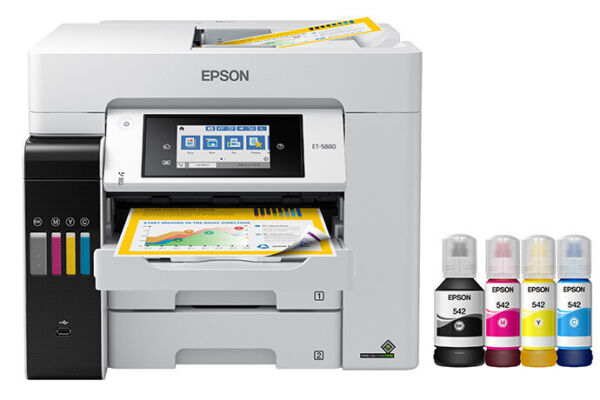
Best inkjet printers like this one raise the bar for home pros. Its huge tanks hold ink for 14,000 black or 5,200 color pages—practically forever. Setup’s done in 30 minutes, including filling ink.
Print quality shines on everything. Text comes out super sharp. Photos show true-to-life colors with smooth blends. It hits 25 pages per minute for black-and-white docs.
Pros:
- Exceptional ink capacity reduces refill frequency
- Professional-grade print quality on all media
- Wi-Fi 7 connectivity for fastest wireless speeds
- Comprehensive warranty covers printheads
- Energy Star certified for efficiency
Cons:
- Higher upfront purchase price
- Large footprint requires dedicated space
- Initial setup takes longer than cartridge models
- Replacement printheads cost more than competitors
Best Budget: Canon PIXMA TR4720

Budget constraints don’t mean compromising on essential features. This compact wireless inkjet printer delivers solid performance at an unbeatable price point. Perfect for students, occasional users, and tight budgets.
Color accuracy surprises given the affordable price. Document text looks crisp and professional. Photo output works well for social media prints and school projects.
Pros:
- Incredibly affordable purchase price
- Compact design fits anywhere
- Easy smartphone setup via Canon app
- Decent photo quality for the price
- Low power consumption
Cons:
- Higher per-page ink costs
- Limited paper capacity (100 sheets)
- Slower print speeds than premium models
- Basic build quality shows with daily use
Best All-in-One: Brother MFC-J1205W
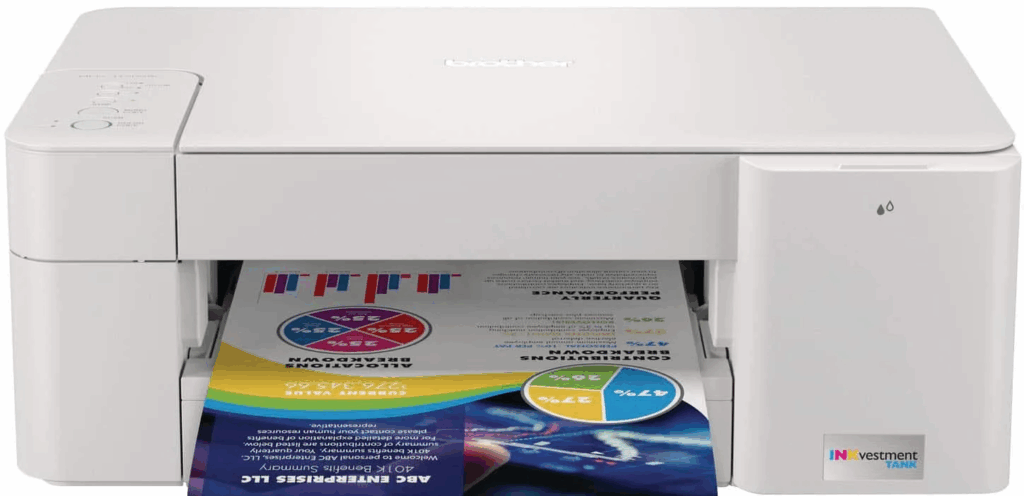
Versatility meets reliability in this feature-packed machine. Scanning, copying, and printing work flawlessly together. Large-capacity cartridges reduce maintenance frequency. Perfect for best home office printer needs.
Document handling impresses with automatic duplex capability. Scan quality reaches 1200 x 2400 dpi for detailed reproductions. Copy speeds hit 12 pages per minute.
Pros:
- High-yield cartridges lower operating costs
- Reliable paper handling mechanisms
- Excellent document print quality
- Easy-to-use control panel
- Strong wireless connectivity
Cons:
- No automatic document feeder
- Limited photo paper handling
- Basic display lacks touchscreen
- Bulky design requires desk space
Best Eco-Friendly: Epson EcoTank ET-5800

Environmental responsibility meets printing excellence. Recycled plastic construction reduces manufacturing impact. Energy-efficient components minimize power consumption. Refillable tanks eliminate cartridge waste.
Print quality matches traditional cartridge systems. Color accuracy works well for both documents and photos. Speed reaches 15 pages per minute in standard mode.
Pros:
- 90% recycled plastic construction
- Eliminates cartridge waste completely
- Energy Star certified efficiency
- Excellent color accuracy
- Comprehensive recycling program
Cons:
- Premium price for eco features
- Slower speeds than conventional models
- Limited specialty paper support
- Ink bottles require careful handling
Best for Home Office: Canon MAXIFY GX7040
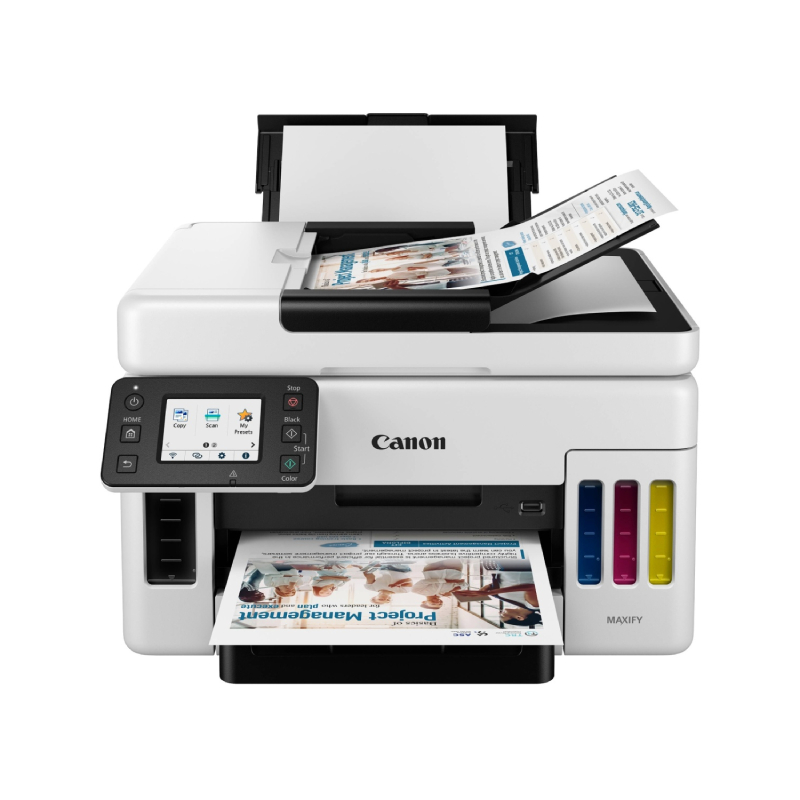
Professional features meet home office budgets. High-capacity ink tanks support heavy workloads. Fast print speeds keep productivity high. Document quality rivals laser printers.
Paper handling accommodates various sizes and weights. Automatic duplex printing saves time and paper. Network connectivity supports multiple users seamlessly.
Pros:
- Fast print speeds (24 ppm monochrome)
- Large paper capacity (350 sheets)
- Professional document quality
- Robust network connectivity
- High monthly duty cycle
Cons:
- Limited photo printing capability
- Higher initial investment
- Bulky design needs dedicated space
- Noisy operation during printing
Best Compact: HP Tango X
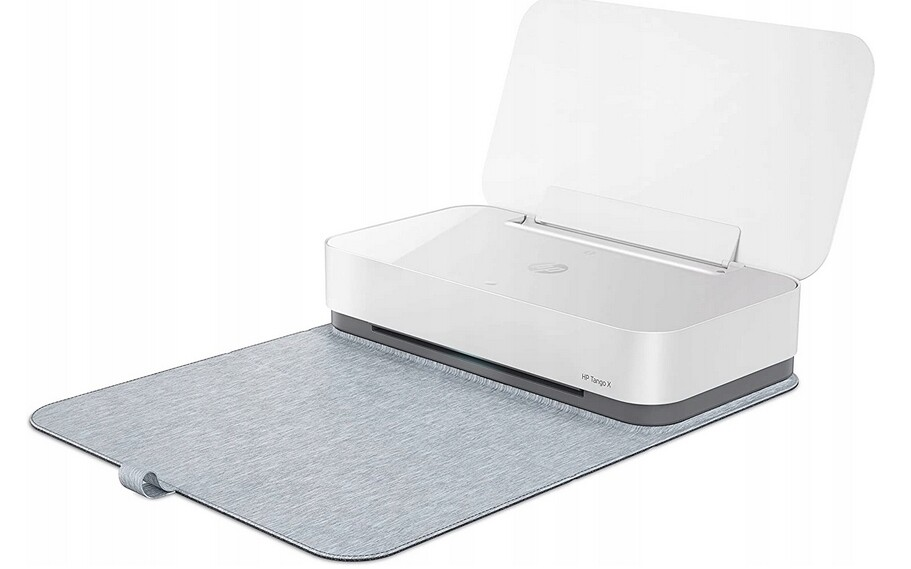
Space constraints meet stylish design. This ultra-compact printer fits anywhere without sacrificing capability. Smartphone-centric design eliminates traditional computer connections.
Print quality impresses despite tiny size. Photo output works well for instant prints. Voice control integration adds convenience.
Pros:
- Ultra-compact footprint
- Stylish modern design
- Strong smartphone integration
- Voice control capability
- Quiet operation
Cons:
- Limited paper capacity (50 sheets)
- Higher per-page costs
- No scanning capability
- Slower print speeds
- Premium price for size
Best High-Volume: Brother INKvestment MFC-J4335DW
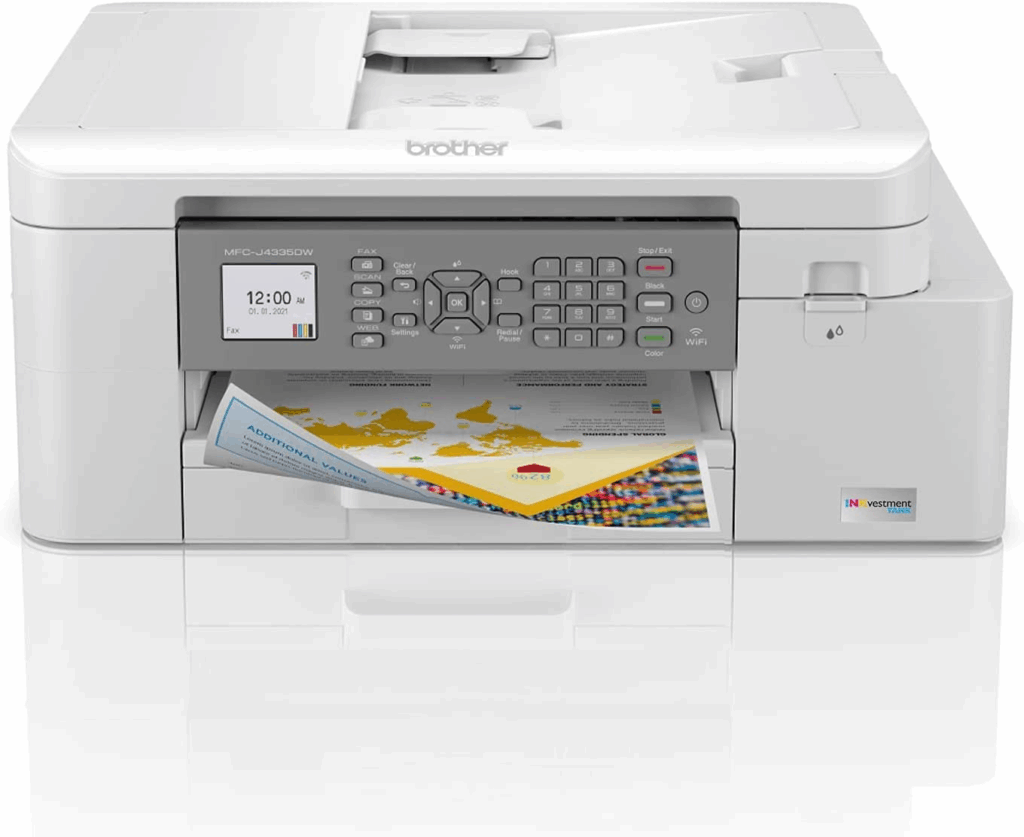
Heavy workloads demand robust construction. This machine handles thousands of pages monthly without breaking down. Large-capacity cartridges minimize supply interruptions.
Print speeds reach 20 pages per minute. Document quality remains consistent through long runs, making it one of the best Inkjet printers for offices. Automatic features reduce manual intervention.
Pros:
- High monthly duty cycle (3,000 pages)
- Large-capacity ink cartridges
- Excellent document quality
- Robust paper handling
- Comprehensive connectivity options
Cons:
- Large footprint requirement
- Higher purchase price
- Limited photo capabilities
- Noisy during operation
Best for Artisans: Epson SureColor P900
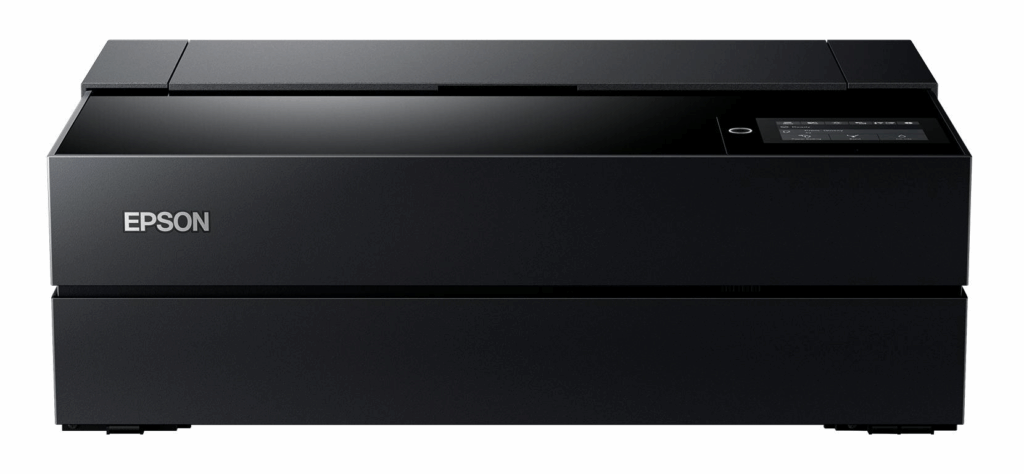
Creative professionals demand perfection. This wide-format printer delivers museum-quality output on papers up to 17 inches wide. Ten-color ink system produces incredible detail.
Color gamut exceeds sRGB standards significantly. Print longevity reaches 200+ years with proper storage. Professional RIP software included.
Pros:
- Exceptional color accuracy and gamut
- Wide format capability (17-inch)
- Professional-grade construction
- Archival print longevity
- Comprehensive media support
Cons:
- Premium pricing structure
- Large space requirements
- Complex setup process
- High ink replacement costs
Best Innovation: Canon PIXMA iP5000
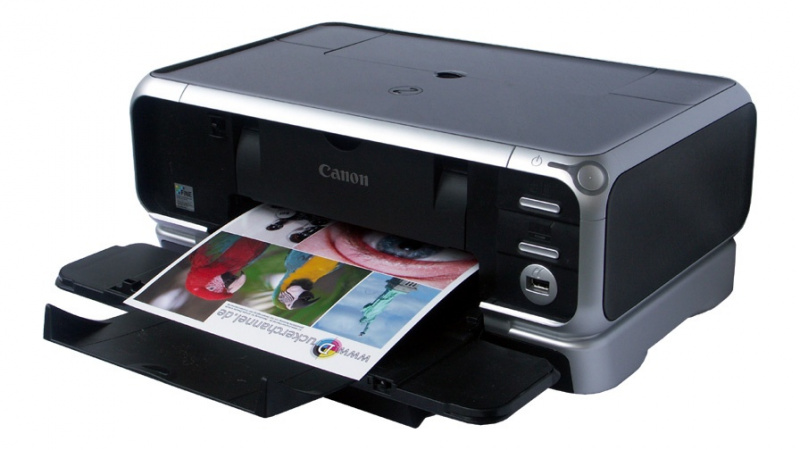
Cutting-edge technology meets practical application. AI-powered color calibration adjusts automatically. Self-cleaning nozzles prevent clogs. Smart home integration works seamlessly.
Print quality benefits from advanced algorithms. Speed improvements come through optimized data processing. User experience simplifies through intuitive interfaces.
Pros:
- AI-powered color calibration
- Self-cleaning printhead technology
- Advanced smart home integration
- Intuitive user interface design
- Future-ready connectivity options
Cons:
- Premium pricing for new technology
- Learning curve for advanced features
- Limited third-party software support
- Higher power consumption
How We Tested
Comprehensive testing methodology ensures accurate recommendations. Each printer undergoes identical evaluation procedures. Real-world usage scenarios reveal practical strengths and limitations.
Print quality assessment uses standardized test patterns. Color accuracy measurements employ professional calibration tools. Speed tests include warm-up times and multiple page runs.
Stress testing evaluates reliability under heavy workloads. Monthly page counts simulate real office environments. Temperature and humidity variations test environmental tolerance.
Printhead maintenance requirements get documented throughout testing periods. Cleaning cycles, nozzle checks, and alignment procedures factor into usability scores.
Buying Guide: Match Your Needs
- For photographers: Prioritize color accuracy over speed. Six-color systems produce smoother gradients. Wide-format capability opens creative possibilities. Professional paper support matters.
- For students: Balance purchase price with operating costs. Compact designs fit dorm rooms. Wireless connectivity eliminates cable clutter. Basic features suffice for most applications.
- For home offices: Emphasize reliability and speed. Document quality should rival laser output. Automatic features increase productivity. Network connectivity supports multiple users.
- For families: All-in-one capability handles diverse needs. Photo printing brings memories to life. Kid-friendly controls prevent accidents. Affordable operation keeps budgets intact.
FAQ: Your Inkjet Printer Questions Answered
Are inkjet printers cost-effective for high-volume printing?
Tank-based systems excel at high volumes. Traditional cartridge models become expensive quickly. Calculate total ownership costs over expected usage periods.
Laser printers often provide better value for pure document printing. Mixed content (text and photos) favors inkjet technology. Business tax deductions affect cost calculations.
How do 2025 inkjet printers reduce environmental impact?
Recycled plastic construction reduces manufacturing impact. Energy-efficient components lower power consumption. Ink tank systems eliminate cartridge waste.
Carbon-neutral shipping options offset transportation emissions. Recycling programs accept end-of-life equipment. Biodegradable inks minimize disposal concerns.
Can I use third-party ink without voiding my warranty?
Warranty terms vary significantly between manufacturers. Third-party inks may affect print quality and reliability. Cost savings often outweigh potential risks.
Tank-based systems typically accept generic inks more readily. Cartridge authentication systems prevent some third-party options. Research compatibility before purchasing.
What connectivity options are essential for smart homes?
Wi-Fi remains the foundation of wireless printing. Cloud connectivity enables remote printing capability. Voice control integration adds convenience.
NFC simplifies smartphone printing setup. Ethernet provides reliable wired connections. USB ports support direct device connections.
How often should I replace printheads?
Replacement frequency depends on usage patterns and maintenance quality. Tank-based systems typically last longer than cartridge models. Print quality degradation indicates replacement needs.
Professional models often include replaceable printheads. Consumer units may require complete printer replacement. Proper maintenance extends printhead lifespan significantly.
Which brands offer the cheapest ink subscriptions?
HP Instant Ink leads in subscription convenience and pricing. Canon Easy-Refill programs provide competitive alternatives. Epson ReadyPrint offers flexible page allowances.
Subscription value depends on actual usage patterns. Unused monthly allowances often roll over. Cancellation policies vary between programs.
Are dye-based or pigment inks better for archival photos?
Pigment inks provide superior longevity and fade resistance. Dye-based inks offer broader color gamuts and smoother gradients. Professional applications typically prefer pigment systems.
Paper choice affects print permanence significantly. Museum-quality papers extend lifespan regardless of ink type. Display conditions impact fade rates dramatically.
Do all inkjet printers support borderless printing?
Most modern inkjets include borderless capability. Paper size limitations apply to borderless modes. Photo-oriented models typically offer more borderless options.
Edge quality varies between manufacturers and models. Specialized photo printers excel at borderless output. Document-focused models may have limited borderless support.

